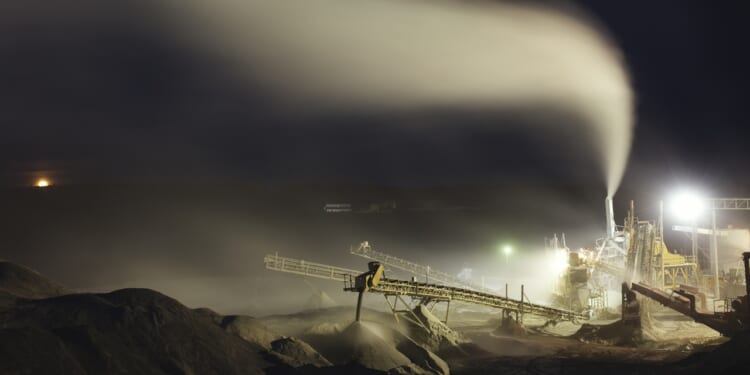Scientists believe that the moon contains heavy rare earth minerals—of the kind needed for the development of advanced military technology such as the F-35 fighter jet.
Like staking out all the water holes in a desert, the People’s Republic of China (PRC) has deftly captured the major sources of the world’s known rare earth minerals. The Chinese have come to dominate the world’s processing of rare earth minerals, too.
Because of this, and the fact that the United States depends disproportionately on rare earth minerals to produce high-end technology, Beijing is using their control over this critical resource to complicate America’s otherwise harsh stance on the trade war. Currently, there are no workarounds for the Americans.
Understanding Heavy Rare Earth Minerals
That’s because the United States lacks both the processing facilities needed to refine the rare earth minerals and the heavy rare earth minerals themselves. The United States is sitting on a treasure trove of light rare earth minerals. But the heavy rare earths are what matter for advanced weaponry and platforms, such as the F-35 Lightning II stealth fighter. China hasn’t bothered to institute harsh export controls over light rare earths, knowing full well that the Americans could pull those from the ground if need be.
Heavy rare earths are another matter entirely. Australia has heavy rare earths, which is one of the reasons American leaders are trying desperately to help Australia enhance their rare earth mineral production. However, even with American assistance, it is unlikely that the United States will be able to depend on Australia to overcome the dominance the Chinese have built for themselves.
There is one place that the United States might be able to acquire a bountiful, uninterrupted source of the heavy rare earth minerals it needs to sustain its industrial base and build for itself the advanced technologies it needs to compete with China.
Bear with me. I know this is going to sound crazy. But the United States might consider pursuing a Manhattan Project for space mining—because the moon, which is only a few days’ journey from Earth, is believed to be drowning in heavy rare earth minerals.
Moon Mining Isn’t as Crazy As It Sounds
A 2009 study assessed that the United States government would need to pour around $35 billion into any permanent manned mining outpost on the moon—with more than $7 billion in maintenance cost on average per year thereafter. In 2025 dollars, that’s roughly $65 billion. It’s a hefty price tag, but a relatively small price to pay if it meant that the United States could divorce itself entirely from China’s rare earth mineral sources.
Plus, creating a permanent manned settlement on the moon would both enhance America’s overall technological development—while ensuring America’s continued dominance in space—and would increase American prestige.
Scientists believe that the moon contains key heavy earth minerals in places like the Procellarum KREEP (K is for the atomic symbol of potassium combined with the acronym for “rare earth elements,” which is “REE,” and the “P” is for the atomic symbol of “Phosphate”) terrane. Lunar basalt can be found in long-dormant volcanic plains on the lunar surface and likely possesses heavy rare earth elements and depleted light rare earth elements in abundance. Meanwhile, one of two major deposits of rare earth mineral elements is found in the lunar South Pole-Aitken (SPA) basin.
It just so happens that the United States and China are racing to build permanent human settlements on the south pole of the moon, with Acting NASA Director Sean Duffy recently advocating placing a nuclear reactor there in the run-up to NASA astronauts establishing a permanent base.
The lunar highlands are believed to have a higher concentration of europium, which is a key rare earth element. Research from Boeing, per Reuters, states: “Rare earth metals are present on the moon, including scandium, yttrium, and the 15 lanthanides.” Scandium and Yttrium are among the heavy rare earth minerals that are required for the production of electronic components, lasers, super conductors, and other technologies.
To Beat China, US Leaders Must Think Outside the Box
No one wants to have this discussion in Washington, partly because space is simply not seen as anything other than a boondoggle by most American policymakers and because the politicians harp on the hefty price tag.
But for a nation that has left a $37 trillion debt and deficit for its people, it seems odd that $65 billion would really be considered too expensive—especially in light of the kind of rewards the United States could reap.
Anyway, the surest way out of America’s dependency problem with rare earth minerals is to immediately begin mining the moon and other nearby celestial bodies, such as asteroids.
Will American leaders have the gumption to take up this call, or will they meekly turn to their new Chinese partners to find more earthbound solutions?
About the Author: Brandon J. Weichert
Brandon J. Weichert is a senior national security editor at The National Interest. Recently, Weichert became the host of The National Security Hour on America Outloud News and iHeartRadio, where he discusses national security policy every Wednesday at 8pm Eastern. He is also a contributor at Popular Mechanics and has consulted regularly with various government institutions and private organizations on geopolitical issues. Weichert’s writings have appeared in multiple publications, including The Washington Times, National Review, The American Spectator, MSN, The Asia Times, and others. His books include Winning Space: How America Remains a Superpower, Biohacked: China’s Race to Control Life, and The Shadow War: Iran’s Quest for Supremacy. His newest book, A Disaster of Our Own Making: How the West Lost Ukraine is available for purchase wherever books are sold. He can be followed via Twitter @WeTheBrandon.
Image: Shutterstock / Salienko Evgenii.

















